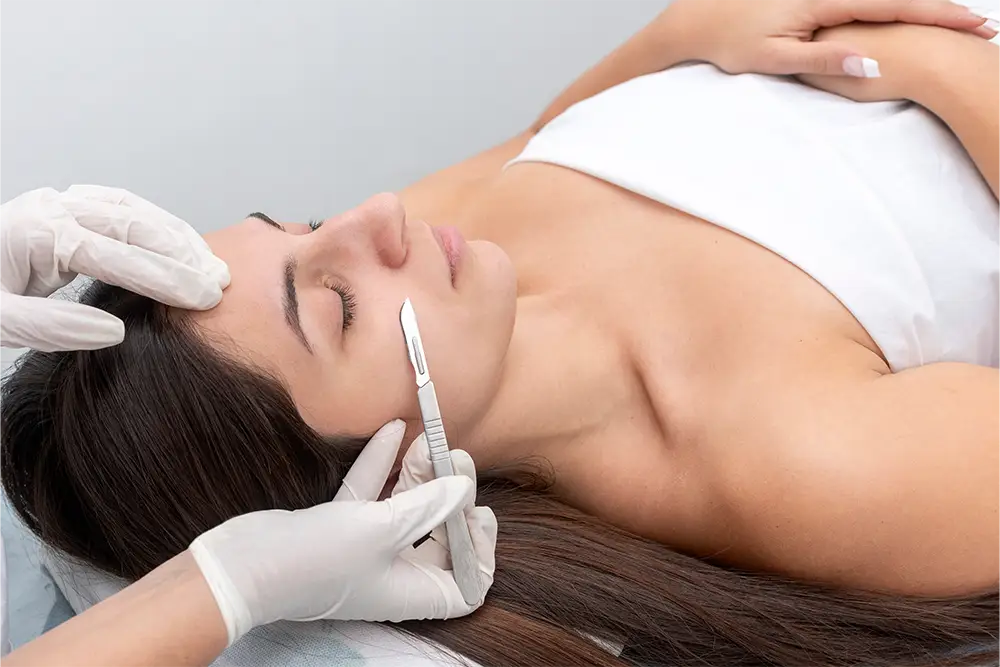Dermaplaning allows those living with imperfections on their faces, such as unwanted hair or scars, to get rejuvenation. Acne affects 80 percent of the population between the ages of 11 and 30. Another five percent will continue to have this skincare problem throughout their lives. One out of five will also experience minor to serious scarring as a result.
Even if the blemishes clear up before you reach adulthood, some people live with them for the rest of their lives thanks to acne scarring. It’s something that will undoubtedly affect how they feel about themselves. Many possible treatment options and help, such as this dermaplaning guide, that can help are available at Venice Avenue Dermatology, including a dermaplaning facial.
What is Dermaplaning?
Dermaplaning is a minimally invasive exfoliation treatment that takes off the skin’s top layer, mostly dead cells. This form of exfoliation is done using a unique scalpel. Some other common names for this process include: microplaning or blading.
It is effective for all skin types and can help fade acne scarring.

Why Do People Get Dermaplaning Done?
The goal of dermaplaning is to remove dead skin cells and hair. The hair taken off with dermaplaning isn’t beards or whiskers but peach fuzz that can affect the look of the skin. The ultimate goal is to give the face a smooth, youthful appearance.
People get this treatment to remove imperfections on their skin, such as:
- Scars
- Dull skin,
- Sun-damage
- Dry skin
- Fine lines
Dermaplaning removes the top layer of skin and all the dead skin cells. The esthetician uses a sterile blade and runs it over the face at a 45-degree angle. There is no incision or cut made. The blade simply drags across the skin to remove what is on the surface.
What Is the Difference Between Dermaplaning, Microdermabrasion, and Dermabrasion?
They are similar in many ways. All three provide immediate results and leave the skin looking and feeling fresher and younger. They each go about it in different ways, though. For example:
- Dermaplaning – Uses a scalpel to remove the top layer of the skin.
- Dermabrasion – Uses a rotating device to remove the top layer of the skin.
- Microdermabrasion – Uses a small applicator with a mildly abrasive surface and an exfoliant to remove the top layer of skin.
The goals are the same with each procedure, but the method differs.
Is Dermaplaning the Same Thing as Shaving?
Dermaplaning is also very similar to shaving. In this case, the two have like methodologies but different goals. Shaving runs a blade across the face to remove something – usually facial hair at the shaft, leaving hair follicles in place. That is all it does, though.
While that is what dermaplaning does, the benefits of dermaplaning go further. It also removes dead skin cells. That exfoliation makes skin look younger and more radiant.
Can You Do Dermaplaning at Home?
DIY dermaplaning is possible and common. It is likely to be riskier at home and possibly less effective. Many people think they can use a standard blade to dermaplane at home. That won’t work as well as the dermaplaning tool a dermatologist uses. The tools are available to the public for people who want to do their own skincare treatment. There are both manual and electric devices available similar to razors.
A clinician will use a fully sanitized tool, as well. You would need an autoclave at home to get the same level of disinfection.
The main benefit of getting it done professionally, though, is quality. The dermaplaning done in a clinic will provide deeper exfoliation and offer longer-lasting results.
Who is a Good Candidate for Dermaplaning?
Anyone looking for face rejuvenation that comes with glowing skin and a younger look can benefit from dermaplaning. It is ideal for those with scarring, age spots, or dull skin. It is also an alternative for someone who fails to respond well to other methods, such as microdermabrasion.
How Much Is Dermaplaning?
The cost will vary based on a number of factors. For example, your location will make a difference. It may be more expensive in bigger cities where the demand is higher. Also, it will depend on the service provider and how many treatments they recommend.
How Is Dermaplaning Done?
During a dermaplaning session, you will lie down on a table fully dressed. A provider will go over your face with a specialized tool or a scalpel. They will hold the sharp blade at a 45-degree angle while dragging it over the skin.
There is no pain during the procedure because there is no incision or cutting. It will feel like shaving. You may feel a tingling as the blade removes skin cells. The treatment does not require anesthesia, although some providers offer numbing and an oral sedative if the patient is uncomfortable.
The procedure takes 20 to 30 minutes and will leave you with skin that feels smoother. Afterward, they may give you moisturizer with SPF to protect your fresh skin

What About Dermaplaning at Home?
You can do dermaplaning at home with the right tools. It is essential that you use the proper equipment to avoid cutting yourself and risking an infection.
It is not a difficult process if you have the right tool. Just follow these simple steps:
- Step One: Wash your face thoroughly with a cleanser before starting. This will clean off debris.
- Step Two: Use a toner on your skin. This closes the pores to prevent breakouts after the treatment.
- Step Three: Use a sterilized dermaplaning tool. Follow the manufacturer’s instructions for sterilizing the blade.
- Step Four: Hold the tool at a 45-degree angle over the skin. Move it slowly, using short strokes over the face. If you feel pain, stop. There may be nicks.
- Step Five: Apply a fragrance-free moisturizer for hydrating. If going outside, make sure to use one with sunscreen in it.
Anyone considering dermaplaning at home should consult their health provider first. Let them ensure it is safe and that there are no other skincare problems that might be affected by the home treatment. For example, it is not recommended for those with active acne, rosacea, or another type of skin irritation.
What Do I Do to Prepare for In-Office Dermaplaning?
The staff will give you a list of instructions to follow before your session. Generally, they will tell you to cleanse your skin and then use a toner. Cleansing will remove dirt and oil from the skin. The toner will close the pores so that dead skin cells don’t clog them up or buildup during the procedure.

What Do I Do After Dermaplaning?
After a dermaplaning session, it is critical that you keep in mind that your skin is vulnerable right now. It is new skin that will be sensitive to irritation and the sun. Follow the post-treatment care instructions from your provider. Typically, they involve:
- Avoid direct sunlight for up to three days.
- Avoid extreme heat like a sauna or hot tub for three days.
- Do not exfoliate or scrub the skin for up to one week,
- Avoid chlorine, such as what is found in swimming pools
- Apply serums like retinoids and lotions to help prevent dry skin.
- Use sunscreen as a skin barrier if going outside. You can use a moisturizer with sunscreen in it, as well.
The care provider might have specific products they want you to use to protect the new skin, like a gentle cleanser.
Benefits and Risks of Dermaplaning
The benefits of dermaplaning include:
- Younger looking skin
- Skin taut and firm
- Fading of scars
- Reduction of fine lines and wrinkles
- Hair removal
The procedure will leave you with a radiant glow.
What Are the Risks of Dermaplaning?
Dermaplaning is a safe cosmetic procedure with few side effects for most people. It does come with some risks, though, such as
- Infection
- Keloids or raised scars,
- Pigment discoloration
The skin around the treated area may look lighter or darker after dermaplaning.
Recovery From Dermaplaning
There is no downtime after a dermaplaning treatment. You can return to your daily activities. Follow the instructions provided by the esthetician carefully. They may recommend changes in your skincare routine and new ways to shave your face if applicable.
How Long Before I See Results From Dermaplaning?
There may be some redness in your skin, which may be sensitive, so use the recommended skincare products. After a few days, that redness will disappear, and you will see the results of your treatment more clearly.
How Long Does Dermaplaning Last?
The results are temporary. In about three weeks, they will fade, the skin may appear dull again, and there may be hair growth.
Most people can benefit from dermaplaning once a month This ensures the removal of dead skin cells, so you always have a fresh-looking appearance.
Venice Avenue Dermatologists provides a range of cosmetic dermatology services, including dermaplaning. While getting a dermaplaning treatment, consider some other ways to reduce aging and approve your appearance such as botox, chemical peels, and microneedling. We also offer dermal fillers. Contact us today to make an appointment.
